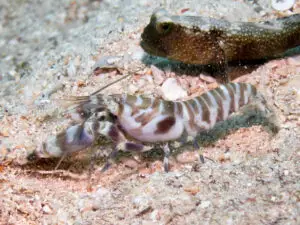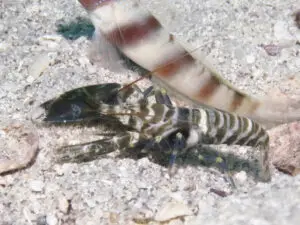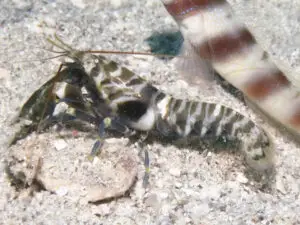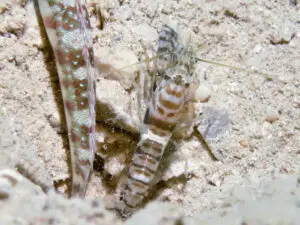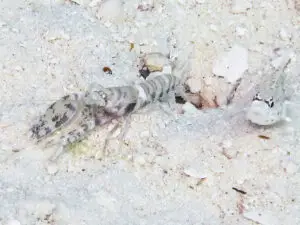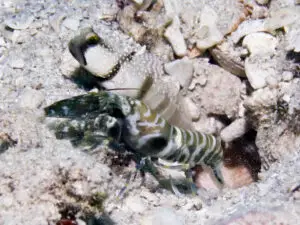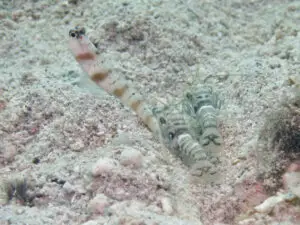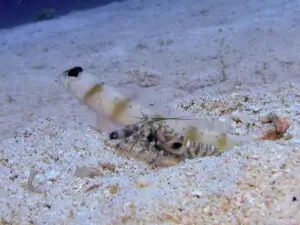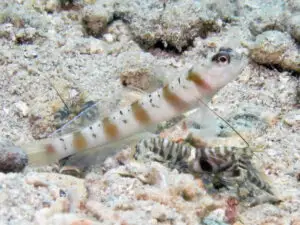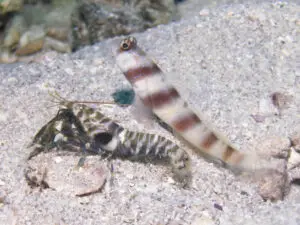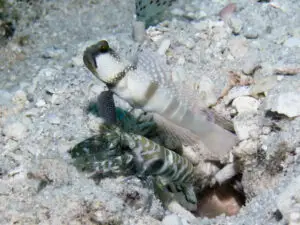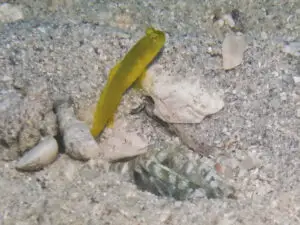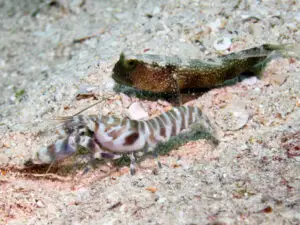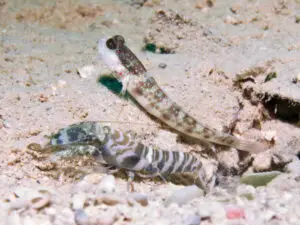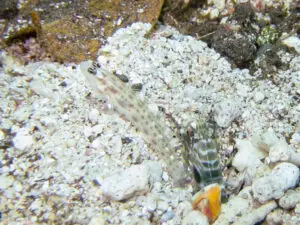Banded Snapping Shrimp
Alpheus species 1
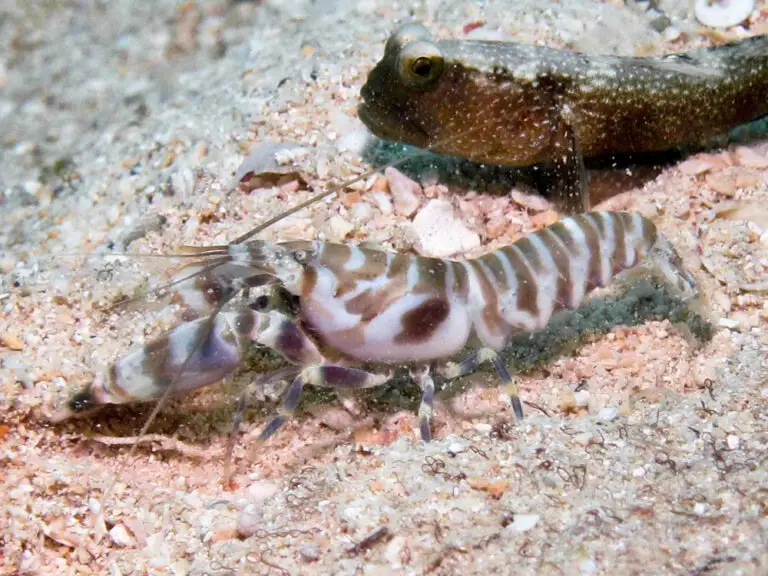
Banded Snapping Shrimp
Alpheus species 1
undescribed
Description
A very distinctive shrimp. It is moderately large, smooth and shiny. It is pale grey with contrasting dark brown-grey banding along the body and pincers and a prominent black patch with a white surround on the lateral side of the carapace.
Carapace. The base colour of the carapace is very pale grey. Viewed from above there is a dark transverse bar at the level of the black lateral patch. Forward of this are three curved bars that taper as they run diagonally forward on the side of the carapace in an irregular fashion. At their dorsal origin they may be solid or broken into two tear-shaped patches. The lateral view of the carapace is dominated by the circular black patch that lies on a white surround.
The abdomen. The segments of the abdomen are very pale grey. Between each a darker grey or bronze band extends the whole width, becoming broader laterally and sometimes terminating in a series of smaller circular black patches on pale grey. There may be a white band on segments 1 and 4.
The rostrum is pale grey with a dark grey band and a bandit’s mask across the eyes.
The appendages are bronze coloured, as are the antennae.
The pincers are pale grey with three dark grey-brown bands. Pollex and dactyl are white in the dominant claw, and mixed light and dark grey in the other.
The chelate second legs and walking legs are dark blue with yellow joints.
The tail fan is pale grey with the scutes outlined in darker grey. There is a dark spot on the endopod and proximal exopod. There are small setae.
The alternating bands on the abdomen and the black patch with a white surround on the carapace are distinctive. Heavy bodied, smooth and shiny.
Variation
There is variation in the degree of pigment but the species remains recognisable.
They can look very strange when there is a marked reduction in pigment, but the details of the pattern are clearly the same.
Similar Shrimps
This is a very distinctive shrimp and not readily confused with any other.
Nomenclature
Ryanskiy (2016) p9. has images of a similar looking shrimp and gives the name Alpheus species, common name Tail-spotted Snapping Shrimp. Length up to 3. 2 cm. Distribution South and Western Pacific – Philippines, Papua New Guinea.
Humann & DeLoach (2010) p85 has images of a similar looking shrimp and gives the name Alpheus species 5, common name Undescribed. Size to 3 cm. Papua New Guinea and Philippines.
Hayashi & Shiratori (2003) Alpheus species 1 from Japan.
Ecology
HABITAT
Preferred substrate They live in coarse sand substrate usually with coral and shell fragments, which are incorporated into the construction of the burrows. They tolerate strong tidal currents.
Depth range 4 to 15 metres
Proximity to reef Burrows are constructed away from the reef itself. They may be seen on reef slopes and further out in current swept channels.
NATURAL HISTORY
An adaptable species that forms an association with at least nine shrimpgoby species. It is strongly built and works in a variety of non-silty substrates.
The contrasting markings probably match dark and light areas on the sand and break up the shrimp’s outline better than might be expected. The black patch with its white surround is conspicuous and may assist recognition by other members of its own species.
The burrow entrance is reinforced with large coral and shell pieces.
Distribution
Published distribution:
Philippines, probably more widespread, (Debelius 2001). South and Western Pacific: Philippines and Papua New Guinea, (Ryanskiy 2016). Papua New Guinea and Philippines, Humann and DeLoach (2010). Flores, Bali and Java, Indonesia. Widespread Indo-Pacific, (Kuiter and Debelius 2009).
Our records:
Australia: Lizard Island, Michaelmas Cay, Fitzroy Island.
New Caledonia; Woodin Canal.
Papua New Guinea; Hermit Islands
Solomon Islands; Ghizo, Kolombangara Island, Maravagi, Soghonangola Island, Soghanara Island.
Associated Goby species
Associated Shrimpgobies (eight species)
Amblyeleotris arcupinna, Arcfin Shrimpgoby
Amblyeleotris rubrimarginata, Redmargin Shrimpgoby
Amblyeleotris steinitzi, Steinitz’s Shrimpgoby
Cryptocentrus cinctus, Yellow Shrimpgoby
Cryptocentrus fasciatus, Y-bar Shrimpgoby
Cryptocentrus leptocephalus, Pinkspot Shrimpgoby
Ctenogobiops mitodes, Thread Shrimpgoby
Ctenogobiops pomastictus, Goldspeckled Shrimpgoby

